1995 $5 Bill:It’s not every day you find a small fortune hidden in your wallet—but for some Americans, that’s exactly what’s happening. A rare 1995 $5 note, featuring the Treasury seal on the reverse, has recently been attracting the attention of collectors and numismatic experts, selling for hundreds—even thousands—of dollars in the collectibles market.
If you have an old $5 note stashed away in your drawer, now’s the perfect time to examine it carefully. Here’s everything you need to know about how to spot this rare printing mistake, why it’s valuable, and how to tell if your $5 note could be worth more than its face value.
What Makes The 1995 $5 Note Special?
The 1995 series of U.S. $5 notes may look like any other series, but a small printing error has made some notes exceptionally valuable. The green Treasury seal, which is usually printed on the right side of the note, appears upside down on some notes in this series.
This type of error—called a “misaligned overprint”—occurred during the second stage of the printing process, when the seal and serial numbers were added after the main design was printed. Because the Bureau of Engraving and Printing (BEP) maintains strict quality control, such errors rarely appear in circulation.
That’s why any legitimate example of a 1995 $5 note with an upside-down seal is considered a collectible treasure.
How to Spot a Reverse Stamp on a 1995 $5 Note?
It takes a keen eye and some patience to spot one of these misprints. Follow this simple checklist to check your note:
| Feature | What to Look For | Why It Matters |
|---|---|---|
| Series Year | “Series 1995” printed below the Secretary of the Treasury’s signature. | Confirms the correct year of issue — only the 1995 series is known for this error. |
| Treasury Seal | Located on the right side of the bill, normally under the word “STATES.” | The rare misprint shows the seal upside down — rotated 180 degrees. |
| Federal Reserve Seal | The black circular seal on the left side of the bill. | Should appear normal — only the green Treasury seal is inverted. |
| Serial Numbers | One on the upper right, one on the lower left, both should match. | Helps confirm authenticity; mismatched numbers may indicate tampering. |
| Condition | Crisp, uncirculated bills are far more valuable. | The better the condition, the higher the collector value. |
| Printing Plate Details | Small “FW” code and plate position letter. | Useful for verifying where and how the bill was printed. |
If your $5 bill meets these criteria, especially with the clearly visible green Treasury seal on the reverse, you may have something very rare.
How Much is it Worth?
The value of a 1995 reverse seal $5 note depends on several factors – the most important being its condition, rarity, and demand.
Here is an estimated price range based on collector data and recent online sales:
| Condition | Estimated Value (USD) |
|---|---|
| Heavily circulated | $100 – $250 |
| Lightly circulated | $300 – $600 |
| Crisp uncirculated | $800 – $1,200+ |
| Certified & Graded (PMG/PCGS) | $1,500 – $2,500+ |
Collectors are willing to pay a premium for notes verified by professional grading services such as Paper Money Guaranty (PMG) or Professional Coin Grading Service (PCGS).
If you believe your note is authentic, consider having it professionally appraised or graded to confirm its legitimacy and maximize its value.
Why are Printing Errors so Valuable?
Printing errors, such as an inverted seal, occur when currency sheets are incorrectly inserted into the overprinting press. Since the BEP immediately destroys defective sheets, only a few ever enter circulation.
Collectors value these errors because they represent an interesting glitch in an otherwise precise system—a physical piece of history where human error and machine perfection met. Each misprint tells a story, and this uniqueness increases both rarity and demand.
How to Verify and Protect Your Bill
If you find a 1995 $5 note that matches the description:
- Handle it carefully – avoid bending or creasing it.
- Compare it to another standard $5 note to confirm the seal is not rotated.
- Have it certified by a certified grading company like PMG or PCGS.
- To maintain its good condition, store it safely in a plastic currency cover or holder.
Never try to “fix” or clean the note – doing so could damage it and significantly reduce its value.
Final Thoughts
The discovery of a $5 note with an upside-down Treasury seal in 1995 reminds us that sometimes small things can lead to big surprises. Although most $5 notes are worth exactly that much, some lucky ones hold a hidden treasure – simply because of a printing mistake decades ago.
So, the next time you pay for coffee or count the notes in your wallet, take a second look. That seemingly ordinary $5 could be worth thousands of dollars, turning everyday currency into a collector’s dream.
Check your pockets – your next paycheck might be printed upside down.

